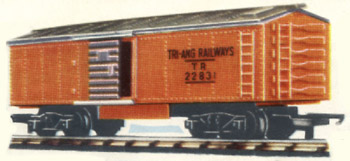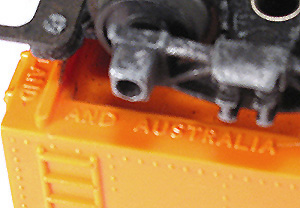
Tri-ang Australian
Moldex R114A Box Car
1958 – 1967
The
Australian R114A Box Car was based on the original

1960
Australian catalogue illustration.
Moldex
shared the tooling for the box car with
Models
were fitted with Australian diecast metal bogies of the early TC pattern with
MkII couplers, sleeved wheels and open axleboxes in 1958 - 59. In 1960 a new
Australian made diecast archbar bogie was introduced using MkIII couplers,
sleeved wheels and open bearings. From about 1963 until production stopped in
1967, the models were fitted with Australian plastic bogies which used MKIII
couplers and the unusual arrangement of sleeved wheels on a pinpoint style axle.
The
tooling was originally made for

The
versions produced by Moldex are summarized in the table below.
Cat. No.
|
Lettering |
Number |
Colour
|
Coupler |
Bogie |
Years |
|
R114A |
Tri-ang
Railways - black |
22831 |
|
MkII |
Metal |
58-59 |
|
R114A |
Tri-ang
Railways - black |
22831 |
|
MkIII |
Metal |
60-61 |
|
R114A |
Tri-ang
Railways - black |
22831 |
White |
MkIII |
Metal |
62-63 |
|
R114A |
Tri-ang
Railways - black |
22831 |
White |
MkIII |
Plastic |
63-65 |
|
R114A |
Tri-ang
Railways - black |
22831 |
White |
MkIII |
Plastic |
66-67 |
|
R114A |
Tri-ang
Railways - black |
22831 |
|
MkIII |
Plastic |
67? |
Information and photographs Graeme Brown